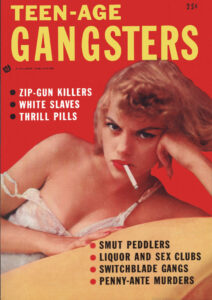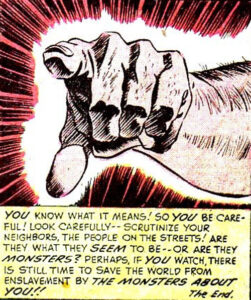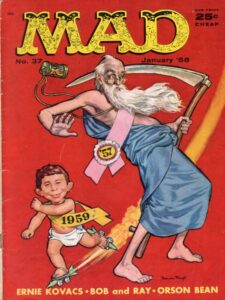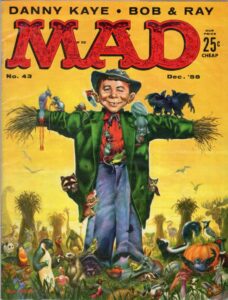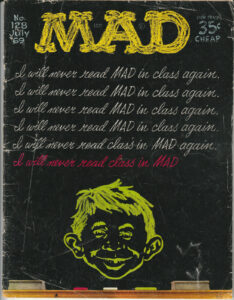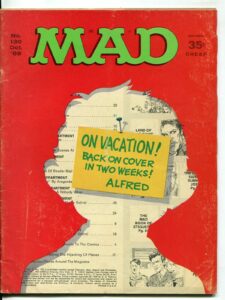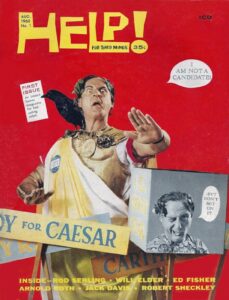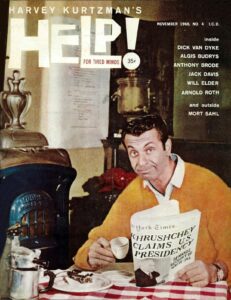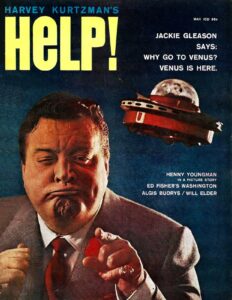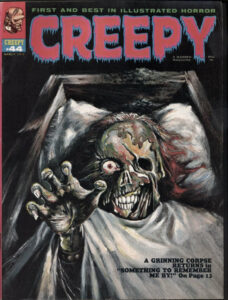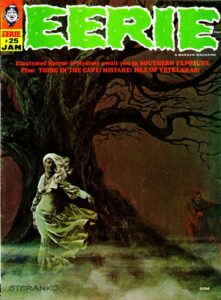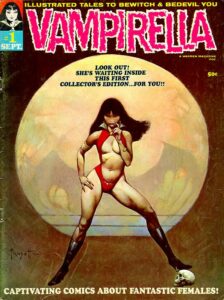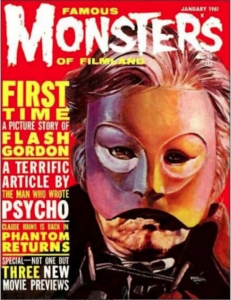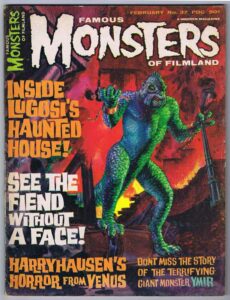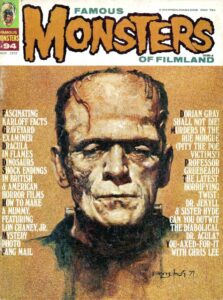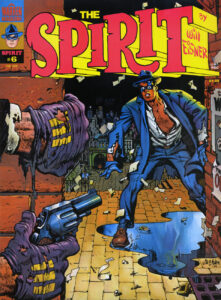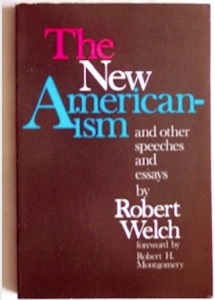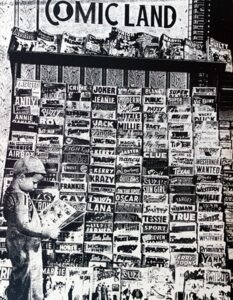MWA NorCal board member Dale Berry is a San Francisco-based writer and illustrator, who has produced independent comics since 1986. His graphic novels (the Tales of the Moonlight Cutter series, The Be-Bop Barbarians with author Gary Phillips) have been published by mainstream, as well as his own imprint, Myriad Publications, and his graphic short stories have appeared in Alfred Hitchcock’s Mystery Magazine, the first comics creator to do so. His 2nd AHMM story (”Dead Air”) was long-listed for the Edgar Award. He and Phillips contributed the ‘Graphic Novels’ chapter to the Agatha award-winning How to Write A Mystery: A Mystery Writers of America Handbook.
(Credits: All images and samples are used for educational purposes only, and constitute fair use. Photo of JBS billboard is from the 1980’s, sadly. Any and all other artworks in this series of articles are public domain, and/or copyright their respective creators and license holders, unless otherwise noted.)
Note: click on an image to see a larger version.
The “Golden Age of Crime Comics,” like the era of crime movies it paralleled, was over. Still, the wake of the Comics Code felt very noir.
In 1958, a visibly disheveled Bob Wood hailed a taxicab. From the back seat, the former Art Director for Crime Does Not Pay, normally a tight-lipped Massachusetts townie, told the driver, “I’m in awful trouble. I’m going to get a couple of hours sleep and jump in the river.”
The cabbie responded, “What happened? Did you kill somebody?”
“Yes,” Wood replied. “I killed a woman who was giving me a bad time in Room 91 of the Irving Hotel. Why don’t you call someone at a newspaper and make yourself a few dollars?”
The cabbie reported Wood to the police, who arrested him at his residential hotel in Greenwich Village. After spending several days with his girlfriend in a Gramercy Park hotel, Wood, beset by drinking and gambling addictions, had beaten and killed her with a clothes iron following an argument. According to artist Joe Simon’s account of the murder, “Wood’s clothes were so bloodied, police borrowed a pair of pants from the hotel manager to take Wood in for questioning.”
Bob Wood was sentenced to three years in prison for First-Degree (Voluntary) Manslaughter. Paroled after two years and eight months, he was arrested six months afterward on a parole violation, finally being released in July 1963. Three years later, he was killed by a car while attempting to cross the Garden State Parkway.
Artfully dodging national criticism and criminal investigation, Harry Donenfeld had quietly retired in 1952, turning executive control of the DC company over to his son Irwin. It remains a dominant force in comics publishing to this day. In 1962, a week before his second marriage, Harry fell and injured his head, resulting in speech impediment and memory loss. He’d pass away in 1965, in a NYC care home, aged 71.
EC’s editor Harvey Kurtzman left Mad over financial disagreements in 1956, and William Gaines later sold Mad Magazine to Premier Industries, a venetian blind manufacturer, in 1961. They in turn sold the rights for a small fortune in 1964 to Harry Donenfeld’s Independent News, Max Gaines’ old partner, which also controlled DC-National. Bill Gaines remained publisher, defending his magazine from its corporate overlords, until his passing in 1992.
EC’s cultural legacy remained influential. Its talent dispersed to surviving companies, becoming mainstays for DC, Marvel and others throughout the decades; some entered teaching, commercial art and the advertising industry. Mad Magazine is still being published. It, along with Tales from the Crypt, The Vault of Horror, even Two-Fisted Tales, have fostered films, books and television series. EC’s approach—social commentary with ironic twist endings, landing on a darkly tongue-in-cheek note—imprinted everything from The Twilight Zone to contemporary blockbusters and became a genre standard; punning, humorous horror-hosts de rigueur.
In 1960, Harvey Kurtzman created the social satire magazine Help! for Warren Publications, publishing early work by screenwriter Charles Alverson, science fiction author Algis Budrys, literary agent/editor Bernard Shir-Cliff, future “underground comix” cartoonists Robert Crumb, Gilbert Sheldon, Jay Lynch and more. Gloria Steinem was Kurtzman’s editorial assistant. Help! featured contributions from cartoonist/staff assistant Terry Gilliam and humorist John Cleese (both meeting for the first time at the magazine, pre-Monty Python) and writer-comedians Woody Allen, Milt Kamen and Orson Bean, among others. Ernie Kovacs, Mort Sahl, Jackie Gleeson and Jerry Lewis stopped by to guest star on covers. Lasting until 1965, to say Help! influenced both the American literary scene and global comedy might be an understatement.
Kurtzman and former EC alumnus Will Elder later partnered to create the satirical, long-running Little Annie Fanny strip for Hugh Hefner’s Playboy. Harvey Kurtzman was also screenwriter for the 1967 animated film Mad Monster Party, would write/direct/design several shorts for Sesame Street in 1969 and teach at NY’s School of Visual Arts beginning in 1973. A comic industry award is named for him.
Help! publisher James Warren, influenced heavily by EC and utilizing much of its talent, would produce the top-selling 1960’s B&W magazines Creepy, Eerie, Vampirella and Famous Monsters of Filmland. This last promoted classic horror, sci-fi and fantasy films, inspiring (as its letter pages can attest) a generation of writers and filmmakers including Stephen King, Steven Spielberg, George Lucas, John Landis, Tim Burton, Joe Dante, Chris Columbus, Peter Jackson, Guillermo del Toro and literally hundreds of others. In the 80’s, Warren would also reprint The Spirit in a deluxe magazine format, re-introducing Will Eisner to yet another generation.
In 2012, a study by Carol L. Tilley found Dr. Fredric Wertham had “manipulated, overstated, compromised, and fabricated evidence” to support his findings in Seduction of the Innocent.
Choice quotes: “He mis-projected both the sample size and substance of his research, presenting it to be more objective and less anecdotal than it truly was. […] He generally did not adhere to standards worthy of scientific research, instead using questionable evidence for his argument that comics were a cultural menace.
“Taking adolescents from troubled backgrounds with previous evidence of behavior disorders as his primary sample population, Wertham used children at the Lafargue Clinic to argue that comics disturbed young people. But according to a staff member’s calculation 70% of children under sixteen at the clinic had diagnoses of behavior problems.” (He also used children with more severe psychiatric disorders which required hospitalization at Bellevue, King’s County Hospital Centers and Queen’s General Hospital.)
“Relevant personal experience was sometimes left unmentioned. In arguing that Batman comics condoned homosexuality because of the relationship between Batman and his sidekick Robin, there is evidence Wertham combined two subjects’ statements into one, and did not mention the two subjects had been in a homosexual relationship for years prior… Despite subjects specifically noting a preference for or the superior relevance of other comics, Wertham gave greater weight to their reading Batman.
“Statements from subjects were altered, combined, or excerpted so as to be misleading. Descriptions of comic content were sometimes misleading, either by exaggeration or elision. He also presented as firsthand stories that he could have only heard through colleagues.” [link: https://muse.jhu.edu/article/490073 ]
The damage wrought by Dr. Wertham and his conservative supporters was profound. In the 1940’s and 50’s, virtually everything produced by the large corporate comic book publishers sold at least 200,000 copies in a nation only about half as populous as today. Sales of fewer than 100,000 to 200,000 copies of anything produced, for example, by DC or Dell would have been grounds for cancellation during that era. Today, only a handful of comics sell more than 100,000 copies, with the vast majority of these going to collectors or sold to regular readers in specialty outlets.
Which brings us, ultimately, to his conservative support. And its motivations.
In 1950, insurrectionist William Dudley Pelley was released from federal prison. Banned from all political activity by the US government, he created a fringe spiritual group centered on UFOs, extraterrestrials and mystical “cosmic wisdom.” That this wisdom included his previous racist teachings should be no surprise. Later charged with securities fraud and living on the margins in North Carolina, he’d pass away in 1955.
Former followers of his Silver Legion continued their involvement with fascist organizations, including Christian Identity during the 1960s (with Silver Legion members John Metcalf and Henry Lamont Beach) and domestic terrorists Posse Comitatus by the 1970s (founded by Henry Lamont Beach). Richard Butler, former Silver Shirt and founder of Aryan Nations in 1978, became a major influence on most insurrectionist groups including the Proud Boys, the Oath Keepers, Patriot Front and the Three Percenters.
In 1958, NAM capitalists, financiers of the Silver Legion, organized the John Birch Society [JBS], co-founded by the late Robert W. Welch of the Welch family confectionary company (Sugar Babies, Junior Mints, Welch’s Grape Juice, etc.). Former member of America First, Welch was on the NAM Board of Directors and regional VP-chairman of its Educational Committee, the Board of Directors of Nabisco and a contributor to both McCarthy and Nixon’s campaigns.
In the mid-1950s, Welch published an open letter declaring Truman (a Democrat) a communist sympathizer and Eisenhower (a Republican) a “possible conscious, dedicated agent of the Communist Conspiracy.” In 1963, his book The Politician proclaimed communism was a front for a global “Master Conspiracy” involving the Illuminati, Rothschilds, a few Rockefellers, and including the Federal Reserve, Trilateral Commission, the IRS and the Council of Foreign Relations. Because, of course it did.
Welch’s co-founder in the JBS was industrialist Fred C. Koch, father of Koch brothers Charles and David, whose current financial-ideological contributions to right wing extremism cannot be minimized.
Using wealthy executive donors and sympathetic media, including Welch’s own New American magazine and Rupert Murdoch’s Fox News Corp., John Birch adherents helped fund and support the NAE’s Christian Right, the Moral Majority, the Tea Party and MAGA, also the Federalist Society, the Heritage Foundation, the America First Foundation, Americans for Prosperity, the Freedom Caucus and Citizens United in anti-ERA, anti-choice, anti-Affirmative Action and anti-union legislation, plus promoted corporate bailouts and Republican gerrymandering. The John Birch’s TRIM committees helped advance the Reagan budget cuts to healthcare, education, environment and the Arts. JBS/NAE politics have exerted profound influence on current conservative policies, both domestic and international. Also, on unprovable conspiracy theories.
Thus, when you witness the Federalist Society’s SCOTUS picks voting for corporations being people and dark money in politics, but against gun control, abortion, voter access and LGBTQ+ human rights; hear politicians parrot Q-Anon reports of a “Deep State” and child trafficking, Florida medical officials claim vaccines contain nanobots and Satanic DNA, or even observe RFK Jr.’s notions of Covid-19 not targeting Jews and Chinese, then wonder where they get their ideas… look no further.
They’re propagating influences, and strategies, from a very old playbook.
The targeting of a comic book’s “threat to society” was, historically, just an important early rung on an entitled, bigoted, autocratic and reactionary ladder. And as a trial run, the Far Right couldn’t have gotten where they are today without it.
But in many ways, as authors, neither would we.
Without the crime and mystery genre, comic books today wouldn’t have evolved the way they have, or created the same social impact—an impact so strong, that comics themselves became stigmatized as criminal, an outlaw and outlier medium. And if not for the romance of that forbidden quality, they wouldn’t keep coming back from the precipice time and again, dragging the crime and mystery genre with them. The elements are linked, and each mirror the other.
Because the history of comic books is also a history of crime, and the society that creates it. It’s a tale of a medium developed to help enable crooked enterprises, only to liberate and legitimize itself, rehabilitating into a genuine universal art form.
Exploited, hobbled, censored by unethical, sanctimonious groups who’d corrupt others for political gain, it only rises again, and yet again, surviving beyond its confines to generate positive influence. Evolving to become a reflection of the world, a social barometer, classic but always current. And elevated or oppressed, always somehow remaining its humble self.
That resilience, what it continues to give back, is proof of this vulgar, low art’s validity as art: it repeatedly feeds creativity, imagination and self-expression in readers, providing inspiration across generations and other mediums across the globe. Just like crime and mystery literature.
And this is where our red threads combine to become a tapestry.
If you pull the strands of either comic books or their various criminal elements, fact and fiction, much of the fabric in popular culture for the last hundred years unravels.

